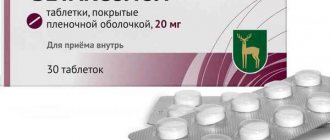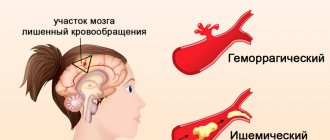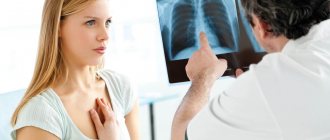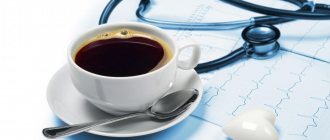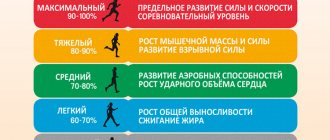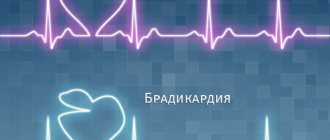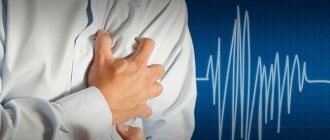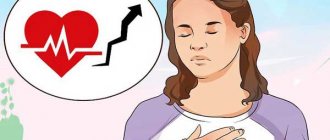Drugs acting on the central nervous system
The most common cause of tachycardia during hypotension is prolonged stress. In this case, sedatives are prescribed that have a calming effect on the central nervous system.
Valerian tablets for tachycardia work in two directions:
- Calms the nervous system.
- Dilates blood vessels and normalizes heart activity.
Other properties of the drug include:
- Eliminate headaches.
- Stimulation of the gastrointestinal tract.
- Fighting flatulence.
- Reduces the frequency of bronchial asthma attacks.
Persen is a combination of sleeping pills and sedatives containing extracts of valerian, mint and lemon balm. This is a combination drug with many active substances. Taking Persen helps:
- Calming effect in excited states, heavy intellectual loads and stress.
- Hypnotic effect for insomnia.
- Antispasmodic effect and decreased vascular tone.
Valocordin also belongs to combination drugs and is intended for the treatment of functional tachycardia, anxiety conditions, and sleep disorders.
Pharmacy tincture of hawthorn also has a calming effect and slows down the heart rate without reducing blood pressure.
Nootropic drugs will help you get out of a depressed and anxious state: Nootropil , Piracetam .
Preventive measures for tachycardia
The occurrence of tachycardia with low blood pressure is not only possible, but also must be prevented. Maintaining a healthy lifestyle should not be underestimated, because basic preventive measures are quite capable of not only preventing a number of diseases, but also saving lives. In order to prevent attacks of increased heart rate due to hypotension, it is recommended to carry out simple preventive measures, namely:
- Regular measurements of heart function. In order to conduct detailed monitoring of blood pressure and heart rate, it is recommended to keep a special journal (notebook) of measurements. This will help to study the factors that contribute to the deviation of blood pressure and pulse from normal.
- Adequate physical activity. If overwork leads to dysfunction of the heart and blood vessels, then moderate physical activity can strengthen and tone the vascular walls and heart muscle.
- Absolute cessation of drinking alcoholic beverages and smoking. Everyone knows about the harmful effects of alcohol and nicotine on the human body, however, few people find the strength to give up bad habits. Nevertheless, during many years of research by leading experts in the world, it was established that people who do not have addictions to smoking and alcohol live not only longer, but also of much better quality.
- Complete and balanced nutrition. The diet must be rich in seasonal vegetables, herbs, fruits, cereals, lean meats and fish. On the recommendation of the attending physician, it is possible to use dietary supplements and vitamins.
- Normalization of work and rest schedules. A properly designed daily routine will help you avoid overwork, both physical and mental. Adequate sleep should play an important role.
Compliance with basic preventive recommendations will significantly reduce the risk of developing a rapid pulse with low blood pressure.
Beta blockers
The mechanism of action of beta blockers is to block the receptors needed by adrenaline and other hormones to stimulate the heart.
Beta adrenergic receptors are found in the myocardium and bronchi. Therefore, you should choose selective drugs that do not cause spasms of the respiratory tract. Such drugs include Egilok .
The drug contains metoprolol , it is a selective beta-adrenergic receptor blocker. The drug selectively acts on receptors located in the heart. It has no non-cardiac side effects.
Taking beta blockers causes certain changes in the body, which include:
- Decreased heart rate.
- Decreased strength of heart contractions.
- Decreased vascular tone of central origin.
- Eliminate arterial spasm.
- Decreased cardiac output.
The relationship between pressure and pulse in the body.
In our body, everything is interconnected. Blood flows through the vessels in order to provide oxygen and nutrition to all organs and tissues. For blood flow to be possible, the pressure in the arteries must be greater than the pressure in the veins. If this condition is met, then blood flows through the arteries towards the veins. The most significant indicator that determines the efficiency of blood flow through human vessels is mean arterial pressure. This value depends on the minute volume of blood circulation and peripheral vascular resistance. Minute volume is the volume of one cardiac output multiplied by the heart rate. Perhaps this theoretical information is a little difficult for a person without a medical education to perceive, but in reality everything is extremely simple. The bottom line is that the body is trying to maintain blood flow at one more or less constant level. Therefore, if for some reason the heart rate increases sharply, the body reflexively reduces the resistance of the peripheral arteries so that the average arterial pressure is not too high. At the same time, systolic pressure drops. Thus, we get a high pulse with low blood pressure. Conversely, if mean arterial pressure drops, for example due to blood loss, the body reflexively increases the heart rate to maintain constant blood flow to the organs. In such a situation, we also get a state with a high pulse and low blood pressure. Thus, pulse and blood pressure are interrelated. And a condition accompanied by a high pulse and low blood pressure may have as its primary basis a decrease in pressure, and an increase in the pulse in this case occurs reflexively, or the primary basis may be an increase in the pulse, and a decrease in pressure in this case occurs as a reflex.
How to reduce heart rate using traditional methods
In folk medicine, there are a number of useful recipes that normalize heart function and reduce heart rate. Some of the recipes:
- Valerian root is soaked in water and then poured with boiling water and soaked for some time. It should be consumed in small quantities, preferably before bedtime.
- An infusion prepared from hawthorn flowers should be taken three times a day, 90 milliliters.
- Tea made from blackcurrant leaves has a beneficial effect on the condition of patients with tachycardia and anemia.
- A spoonful of natural honey a day normalizes heart activity and pulse condition.
- Chamomile and mint tea has a calming effect on the nervous system and improves the general condition of the body.
How to prepare your own mixture of motherwort, valerian and Corvalol tincture to relieve an attack of tachycardia:
To treat tachycardia with low blood pressure, standard antiarrhythmic drugs are not used, since at the same time they can further reduce the pressure and aggravate the condition, leading to collapse. To achieve the effect, you must constantly consult with your doctor, adjust the treatment and follow all medical recommendations.
How to relieve the condition at home?
If tachycardia occurs for the first time with low blood pressure: what to do? The feeling when your heart is pounding in your chest, your eyes are darkening and cold sweat appears can frighten anyone who has not previously encountered this condition, but you should not give in to panic. Fortunately, tachycardia is treatable. Therefore, at the first signs of the disease, it is necessary to contact a cardiologist and undergo simple diagnostic tests, through which the true cause of tachycardia at low pressure will be determined. This will make it possible to develop treatment tactics, which, depending on the stage and origin of the disease, can be based on medications or traditional medicine.
But if this condition occurs at home and there is no way to seek medical help, then, depending on what preceded the attack of tachycardia, you can do the following:
- use medications that normalize heart rate;
- prepare simple traditional medicines or use existing preparations;
- perform activities that can ease your general well-being (for example, breathing exercises) and relieve physical and nervous tension.
As for antiarrhythmic drugs, the following are well suited in this situation:
- "Phenazepam." This remedy reduces nervous excitability and has a calming effect.
- "Mezapam." The drug is suitable for people suffering from vegetative-vascular dystonia, which could provoke an increase in heart rate with low blood pressure.
- "Grandaxin". Being a psychovegetative regulator, the drug helps with cardialgia, neuroses, and muscle atrophy. Providing a calming effect, it normalizes heart rate and blood pressure.
- "Valocordin". Fights muscle spasms and normalizes the functioning of the heart muscle.
- A tincture of valerian purchased at a pharmacy will quickly relieve psycho-emotional stress, have a relaxing effect and help you have a good rest.
When resorting to medicinal methods of normalizing the pulse, you must be careful and strictly follow the instructions for use. If you uncontrollably take any drugs that affect the heart and blood vessels, you can greatly reduce your blood pressure, which will lead to a hypotensive crisis. The possibility of arrhythmic shock cannot be excluded. That is why, before use, you must consult a specialist and agree with him on the dosage and duration of the course of treatment.
If a rapid pulse begins as a result of severe fatigue (which also provokes low blood pressure), it is recommended to open the windows and take a horizontal position for 20-30 minutes, try to relax as much as possible.
Performing breathing exercises will help stabilize the heart rate; for this you will need to take deep breaths, holding the air for a few seconds, and then, making a tube with your lips, slowly release it. If you do not experience dizziness or pain, you can add light swings of your arms, raising them high above your head as you inhale and gently lowering them as you exhale.
How to treat tachycardia with low blood pressure using folk remedies? There are several effective ways to normalize blood pressure and heart rate:
- Pour four tablespoons of blue cornflower into two liters of boiling water, cook in a saucepan for five minutes, then strain and let it brew for a while. At the first signs of tachycardia, drink half a glass of the decoction. For the chronic type, the disease can be treated using this method by consuming 150 ml of the product daily for two months.
- Divide 0.6 liters of freshly squeezed oat juice into 4 parts and drink throughout the day.
- Place 6 tbsp in a teapot. tablespoons of hawthorn fruit, green tea and motherwort leaves in equal proportions, then pour boiling water and brew. The resulting drink can be drunk as a disease prevention or during heart palpitations.
- Mix three tablespoons of walnuts with about one tablespoon. lemon and honey. This product is good at stopping attacks of tachycardia.
Healing remedies prepared according to traditional medicine recipes have a positive effect on the functioning of the central nervous system, normalize blood pressure and heart rate. But it is advisable to use them as an addition to the traditional method of treating the disease or as a preventive measure.
Tachycardia with low blood pressure
Saratov State Medical University named after. IN AND. Razumovsky (SSMU, media)
Level of education - Specialist
1990 – Ryazan Medical Institute named after Academician I.P. Pavlova
Pressure indicators help assess the state of a person’s health, or more precisely, the cardiovascular system. Measuring blood pressure is one of the primary ways to diagnose many dangerous diseases! This indicator can either increase or decrease, it all depends on the failures occurring in the cardiovascular system.
It is generally accepted that the beginning of an attack of tachycardia is the moment when the heart rate rises to 90 beats in one minute! The patient begins to feel dizzy and have a headache, nausea appears, sometimes ending in vomiting. A person may even lose consciousness.
Why can blood pressure drop when your heart rate increases?
Heart rate and blood pressure indicators are interrelated. First, a decrease in blood pressure may occur, and then the heart rate may increase. In more rare cases, the opposite happens. Why does a person have low blood pressure and high pulse?
Sinus tachycardia, accompanied by an increase in heart rate up to 140 per minute, is usually not accompanied by a decrease in blood pressure. Low pressure and high pulse at the same time are most often observed with paroxysmal tachycardia, when the heart rate reaches 140 - 220 per minute.
Paroxysmal tachycardia is a sudden acceleration of the heart rate under the influence of electrical signals located in addition to the main source of such impulses. They cause a pronounced increase in heart rate, which is accompanied by a decrease in the amount of blood that is ejected from the heart into the vessels. As a result, minute volume of blood flow falls and blood pressure decreases. However, this does not always happen, and an attack of paroxysmal tachycardia may well be recorded with normal or even elevated blood pressure.
How to reduce heart rate with high blood pressure in this case? It is not recommended to take any medications on your own. Most of them have an arrhythmogenic effect, that is, they can cause a new heart rhythm disorder. Therefore, an ambulance doctor must act in an emergency situation.
Causes
This diagnosis is made to people who contact a specialist with a complaint of a significantly increased heartbeat. You need to know what causes tachycardia at low blood pressure in order to prevent the disease before it appears! Here are the main predisposing factors to tachycardia:
- Constant stress.
- Bad habits (alcohol has a terrible effect on the heart).
- Abuse of carbonated drinks and coffee.
- Excessive physical activity.
And the most common reasons causing tachycardia at low pressure include:
- Atherosclerosis.
- Serious blood loss.
- Pregnancy.
- Heart damage.
- Vegetative-vascular dystonia.
- A state of shock that occurs for any reason.
- Damage or inflammation of any internal organ.
- Dehydration.
- Taking certain medications that affect the functioning of the cardiovascular system.
- Overwork, lack of sleep for a long time.
Causes of pathology
A strong heartbeat reaching 100 beats per minute is called tachycardia. The development of pathology against the background of hypotension indicates serious changes in the body.
Rapid heart rate is a symptom, not a separate disease. The combination of a rapid pulse and low blood pressure is rare. To restore heartbeat and blood pressure, you need to find the cause of the pathology, which may be hidden in concomitant diseases or stress experienced. Some medications can lower blood pressure, while heart rate increases. This condition negatively affects the body and requires qualified medical care. Self-medication leads to serious complications.
Enter your pressure
Diseases
When you have pericarditis, the blood in the heart is pumped more slowly, resulting in low blood pressure.
- Pericarditis. As a result of the inflammatory process, fluid accumulates in the pericardial sac, which compresses the myocardium and negatively affects its functioning, which leads to changes in blood pressure and heart rate.
- Embolism. A dangerous pathology characterized by blockage of an artery by a detached blood clot.
- Increased heart rate due to hypotension occurs in people with weakened heart muscle (for example, after myocarditis).
- Atherosclerosis. The functioning of the cardiovascular system is impaired due to blockage of blood vessels by cholesterol plaques.
In addition to heart disease, the following diseases affect blood pressure and heart rate:
- diabetes;
- vegetative dystonia;
- inflammatory process in any internal organ;
- allergy.
What other reasons could there be?
One of the reasons for unstable blood pressure is a lack of proper rest.
Low blood pressure during cardiac tachycardia may have the following causes:
- Heavy bleeding (due to injury, heavy menstruation, or internal bleeding due to peptic ulcer). Due to rapid blood loss, blood pressure drops sharply.
- Dehydration. Occurs due to diarrhea, vomiting or frequent excessive urination due to kidney disease. A decrease in fluid levels in the body affects blood volume, which affects blood pressure and heart rate.
- Any type of shock (anaphylactic, traumatic, psychological).
- Pregnancy. Low blood pressure and tachycardia occur frequently during pregnancy. This is explained by the negative effect of the hormone progesterone on blood vessels, a decrease in hemoglobin, and an increase in blood volume in the body of the expectant mother.
- Heatstroke.
- Lack of vitamins and microelements in the body.
- Side effect of the prescribed medication.
- Frequent stress, physical and psychological fatigue, insufficient rest.
- Bad habits, poisoning the body with nicotine or alcohol.
Symptoms
Tachycardia with significantly reduced blood pressure is accompanied by various symptoms, the main one of which is a rapid heartbeat, which interferes with normal well-being. It is impossible not to notice this symptom, as it causes a lot of inconvenience: you will quickly tire, will not be able to work productively, and any physical activity will cause instant shortness of breath and fatigue. Some patients note the similarity of this symptom to a stressful situation, when the heart begins to beat very quickly.
But, unfortunately, attacks can drag on for long periods (up to one day); in such situations, the heart rate sometimes reaches 200 beats in one minute! In such a situation, consult a doctor immediately by calling an ambulance. Also, during attacks, symptoms of hypotension often appear, which occurs simultaneously with tachycardia. You can measure your pulse without special devices! This disease is also characterized by such symptoms as severe pain in the chest area, heaviness in the stomach, and you may even experience digestive problems!
Symptoms of the disease
Against the background of low blood pressure and increased heart rate, discomfort and even severe pain in the heart may occur. The main symptoms of this pathology include:
- dyspnea;
- sweating;
- dizziness;
- nausea;
- feeling of heartbeat;
- darkening of the eyes (pre-fainting);
- asthenia;
- depression;
- increased fatigue;
- headache;
- panic states;
- weakness;
- feeling of a lump in the throat or stomach.
This clinical picture is often observed when a person has VSD (vegetative-vascular dystonia), which is accompanied by attacks of tachycardia and chronic low blood pressure. These are so-called specific crises.
The pathology can occur in people who do not have serious diseases or congenital heart defects, and can be caused by the external conditions in which they find themselves (for example, stressful situations, severe fatigue, heavy physical activity). Manifestations of tachycardia in such cases are temporary and go away on their own. But most often the disease is a signal about the presence of other pathologies in the body.
Diagnostic methods
Since tachycardia along with low blood pressure is quite rare, diagnosing this disease can sometimes cause problems. The fact is that the disease can be determined at the initial stage only by the patient’s complaints, and the correct diagnosis can be made only after the following studies:
- UAC. To begin with, doctors prescribe a general blood test. Thus, it is possible to assess the general condition of the body and exclude other possible diseases. OAC also allows you to prevent tachycardia and begin to fight it before the first attacks appear.
- X-ray. Using X-rays, you can identify many damage to the cardiovascular system that lead to tachycardia with low blood pressure.
- Echocardiogram. This procedure will help to detect with maximum accuracy any damage to blood vessels or even the myocardium.
Urgent Care
An attack of low blood pressure and tachycardia can occur completely suddenly. Dangerous symptoms can also appear in a young person. Therefore, it is important not only to know the basic principles of providing first aid, but also to be ready to provide it at any time and in any place.
The algorithm for providing first aid is as follows:
- Call an ambulance. Especially if it is not possible to independently measure blood pressure, or the person’s condition worsens.
- The person must be laid on his back, on a flat surface, with the leg end raised. To do this, it is recommended to place a pillow, a cushion of clothing under your feet, or hold your feet with your hands (if first aid is provided on the street). If it is not possible to lay the person down, it is necessary to help him take a sitting position, in which his head must be lowered between his legs, to a level below the knees.
- Release from oppressive, constricting clothing (unfasten the top buttons, zipper), ensure a flow of fresh air.
- If a person is shivering, it is recommended to warm him up by covering him with a warm blanket or jacket (when first aid is provided outside). You can offer to drink warm sweet tea.
- It is important to constantly talk to the person, reassure, encourage.
First aid for tachycardia
Correct and timely provision of first aid will significantly alleviate the patient’s condition before the ambulance arrives and reduce the risk of developing serious complications in the future, such as a heart attack or stroke.
Treatment
Treatment of tachycardia at relatively low pressure should be comprehensive. In fact, medications are not always required because the situation can be resolved with certain lifestyle changes. Below are common tips from experts.
Basic recommendations
Medications for tachycardia and low blood pressure are required only in situations where, after implementing the following methods of getting rid of the disease at home, the disease has not subsided.
- Restore proper blood circulation. To do this, lie down and raise your legs slightly above heart level.
- Bring your work schedule back to normal, don’t overexert yourself, try to limit the number of stressful situations.
- Move more, take walks.
- During attacks, perform simple breathing exercises (take as deep a breath as possible, try to hold your breath and exhale slowly).
Medications
If there is no reduction in symptoms, and the tachycardia continues to progress, then you need to start taking medications, which are divided into 4 large groups:
- Antiarrhythmic. Drugs for tachycardia and low blood pressure included in this group help normalize heart rhythm. These medications are very effective, but they can be hazardous to health if taken without the advice of a specialist. The drugs are unique, each of them is prescribed in individual situations.
- Sedatives. The drugs included in this group do not improve the condition of the cardiovascular system. They calm a person by affecting the nervous system! Such medications do not cause any particular harm to the body, but taking them without a doctor’s prescription is still not recommended.
- Beta blockers. Drugs in this group also have an effect on the nervous system, weakening hormones that cause stress. This gives an effect, because they are the ones that cause tachycardia!
- Cardiac glycosides. Such drugs will also help treat tachycardia that occurs with low blood pressure. They fight heart failure and also help improve the condition of blood vessels and heart muscles.
Drugs for cardiac tachycardia: TOP 5 effective drugs, instructions for use, prices in the pharmacy
Tachycardia is a condition accompanied by an increase in heart rate above 90 beats per minute.
Tachycardia can be physiological, for example, during physical activity or anxiety, as well as pathological. Pathological tachycardia is accompanied by episodes of increased heart rate at rest; this condition requires immediate treatment. Medicines for tachycardia and palpitations are prescribed by a doctor after a thorough examination and all necessary diagnostic measures.
Medicines to treat tachycardia
Episodes of rapid heartbeat are usually symptoms of an underlying disease that occurs in a latent form. Depending on the underlying disease, it is possible to use different groups of drugs to restore heart rate. The doctor decides which specific medicine needs to be taken.
The list of essential medicines includes:
- beta blockers,
- sodium channel blockers,
- calcium channel blockers,
- potassium channel blockers,
- cardiac glycosides,
- sedatives.
Cardiomyocyte receptor blockers
Beta blockers are a group of drugs that help reduce heart rate and lower blood pressure by blocking beta adrenergic receptors. As a result of blocking the receptors, adrenaline and norepinephrine do not affect the myocardium and the heart begins to contract less frequently.
Beta blockers come in the following types:
Selective and non-selective beta-blockers have the same effect on tachycardia attacks and blood pressure, but cardioselective drugs have fewer side effects.
Drugs that affect the flow of ions through the cardiomyocyte membrane
Sodium channel blockers exert their effect by inhibiting the penetration of sodium ions into the cardiomyocyte. As a result of these actions, excitability decreases and the conduction of impulses through the heart slows down, which leads to a decrease in the manifestations of arrhythmia. This group includes procainamide, quinidine, lidocoine hydrochloride, propafenone.
Calcium channel blockers inhibit the penetration of calcium ions into myocardial cells from the intercellular space. As a result, myocardial conduction slows down, contributing to a decrease in heart rate, and dilation of the coronary vessels occurs.
More often used:
Potassium channel blockers inhibit the penetration of potassium ions into cells. As a result, the automaticity of the sinus node decreases, atrioventricular conduction slows down, which leads to a decrease in the heart rate and dilation of the coronary vessels. Amiodarone and sotalol are used.
Cardiac glycosides are herbal preparations. The effect is achieved by inhibiting the conduction of nerve impulses in the conduction system. Digoxin belongs to the group of glycosides.
Sedatives
Sedatives used to reduce heart rate are divided into two groups and are considered relatively safe:
- of plant origin. These drugs contain herbal extracts that have a sedative effect and normalize the functioning of the nervous system and heart. These drugs act gently, without having a strong effect on blood pressure. These include tincture of valerian or motherwort, persen.
- synthetic. Prescribed by a doctor, they have an effect on the cardiovascular and nervous system, and have a hypnotic effect. Synthetic sedatives include Relium (Diazepam) and others.
Attention! Medicines for the treatment of tachycardia, as well as the dose and frequency of medications, are prescribed only by a doctor on an individual basis. You cannot prescribe or stop taking medications on your own. Failure to comply with the dose and frequency of administration can lead to an overdose or, conversely, insufficient effect of the drugs.
Treatment of tachycardia with low blood pressure
Blood pressure is considered low at the following values:
- systolic - below 90 mm Hg. Art.,
- diastolic – below 60 mm Hg. Art.
Some people have persistently low blood pressure due to a hereditary predisposition. It is advisable for such people to avoid stressful situations, not to overload, and to monitor their health.
Drugs used to treat tachycardia reduce blood pressure, and if a person initially has low blood pressure, then taking medications to improve well-being without a doctor’s prescription is dangerous.
Important! Uncontrolled use of antiarrhythmic drugs can lead to a sharp decrease in blood pressure, deterioration of blood supply to vital organs and fainting.
Low blood pressure with tachycardia
First aid is as follows:
- you need to lie down and raise your legs,
- drink sweet tea. The use of coffee and caffeinated drinks is prohibited,
- take a deep breath and hold your breath for a while,
- It is possible to use sedatives - motherwort tincture.
If the condition does not improve, lethargy, weakness, and dizziness appear, then it is necessary to urgently call an ambulance.
The hospital will conduct a set of necessary examinations to determine the cause of tachycardia due to hypotension. Based on the data obtained during diagnosis, a diagnosis is made and a treatment plan is prescribed.
Treatment is mainly aimed at eliminating the etiological factor that caused the increased heart rate. The complex of treatment measures also includes taking vitamins and physiotherapeutic procedures.
Medications for normal blood pressure
Tachycardia at normal pressure is most often physiological in nature. Increased heart rate occurs during emotional stress, physical activity, stressful situations, and anxiety. In this case, you need to calm down, reduce the load, and, if necessary, take a sedative.
If episodes of increased heart rate occur frequently and at rest, you should immediately consult a doctor. The doctor will refer you to the necessary procedures and determine the exact cause of the tachycardia.
After identifying the cause of episodes of rapid heartbeat, the doctor prescribes appropriate treatment taking into account the individual characteristics of the patient’s body, the presence of concomitant pathology, and also depending on contraindications to certain drugs.
Emergency care for tachycardia
At home, if tachycardia occurs, the following measures are taken:
- you need to take a horizontal position,
- you can drink a sedative of herbal origin,
- If the patient has previously had an attack of tachycardia, the cause is known and the patient has recommendations for treatment, then you can take the medicine that was prescribed by the doctor to stop the tachycardia.
If the measures taken do not lead to restoration of the heart rhythm, then it is necessary to call an ambulance.
Treatment of tachycardia with high blood pressure
Blood pressure is considered high at the following values:
- systolic - above 140 mm Hg. Art.,
- diastolic – above 90 mm Hg. Art.
The combination of tachycardia and high blood pressure is very dangerous. During attacks, there is a strong load on the heart with a simultaneous lack of oxygen-rich blood supply to the myocardium.
Important! A prolonged attack of tachycardia against a background of high blood pressure can cause the development of serious heart problems and therefore requires urgent treatment. You need to call an ambulance immediately. Before the ambulance arrives, measures must be taken to try to stabilize the process.
Principles of first aid
Principles of first aid for a combination of tachycardia and high blood pressure:
- try to breathe deeply,
- it is possible to use vagal techniques - hold your breath, induce a gag reflex, lightly press on the eyeballs, cough,
- wash your face with cold water,
- drink a sedative
To prevent the development of attacks of rapid heartbeat during hypertension, it is necessary to select the optimal treatment based on the general condition of the patient and the presence of concomitant diseases.
In addition to drug treatment for hypertension, vitamin therapy and physiotherapeutic procedures are used. It is necessary to normalize sleep and wakefulness, eat right, give up bad habits, lead a healthy lifestyle, and avoid stressful situations.
Tachycardia is not an independent nosological entity, but it can complicate the course and be a symptom of many diseases of various organs and systems. Therefore, it is very important to promptly identify the cause of attacks of rapid heartbeat and choose the right medications for tachycardia.
Every person should prevent the development of episodes of rapid heartbeat and know how to behave during an attack.
(2 3,00 of 5) Loading...
Source: //KardioBit.ru/bolezni-serdtsa/davlenie-i-puls/preparaty-ot-tahikardii
Why does this happen
Tachycardia is an increase in heart rate above 90 per minute. The normal heart rate is from 60 to 89 beats per minute. If this is a one-time attack of tachycardia that goes away on its own, you don’t have to think about any disease.
When increased heart rate appears with low blood pressure, and this condition occurs regularly, this is a sign of pathological changes in the heart muscle. This can be either an acute condition or a chronic heart disease.
It is important that drugs used to normalize heart rhythm also tend to lower blood pressure, so prescribing them to hypotensive patients is undesirable.
The dangers of low blood pressure and high pulse
Hypotension in combination with tachycardia is very dangerous. This symptom not only causes weakness of the heart muscle, but also leads to constant shortness of breath, weakness, and decreased performance.
A malaise that many do not take seriously leads to:
- heart attacks and strokes;
- Alzheimer's disease;
- ischemia;
- dementia.
Often such health problems end in death.
The best prevention of high heart rate with low blood pressure is a healthy lifestyle, sufficient physical activity, regular contrast showers, and the presence of foods high in potassium and magnesium in the diet.
If problems cannot be avoided, do not postpone your visit to the doctor. A timely and correctly drawn up treatment regimen will help avoid disastrous consequences and restore health.
What to do if you have tachycardia
If a person knows that he often has attacks of tachycardia, he should take some preventive measures:
- adhere to a healthy lifestyle;
- eat healthy and regularly;
- allocate at least 8 hours a day for rest and sleep;
- take a contrast hardening shower every day;
- completely give up bad habits, especially smoking;
- spend more time in the fresh air;
- do daily physical exercise.
Proper nutrition involves a balance in the daily menu of proteins, fats and carbohydrates. You need an appropriate amount of food and its energy value for physical activity. To normalize blood pressure, it is recommended to drink green tea, eat apples and pomegranates. Frequent consumption of coffee increases vascular tone, but also increases the heart rate, so you need to treat this drink with caution.
For persistent stress, it is recommended to consult a psychotherapist.
In addition, it is necessary to keep a diary of blood pressure, and if persistent hypotension occurs, consult a doctor to adjust medications. People with hypotension and frequent attacks of tachycardia, as a rule, feel the approach of such a condition in advance and know what can cause it.
What can be done to prevent the condition
With an accelerated heartbeat, patients panic and do not know what to do. You need to open the window, unfasten your collar, loosen your belt and drink water. If anxiety grows very quickly, then you urgently need to drink a sedative - Corvalol or valerian. If the pressure is significantly reduced, then you should stop taking sedatives and drink, for example, coffee.
Advice! Proper breathing is the key to calm, so try to breathe at long intervals and slowly inhale/exhale. Some doctors advise stimulating the vagus nerve in indirect ways:
- Press firmly with your fingers on the eyeballs for several seconds;
- Repeat the process 3-4 times.
Sometimes a rapid heartbeat with low blood pressure is a harbinger of a cardiovascular disaster. If your health worsens, you should immediately call an ambulance. Prescription medications should be taken strictly under the supervision of the attending physician.
Why does tachycardia occur with hypotension?
The combination of these two symptoms is always a pathological sign. What heart problems can cause this condition? The causes of tachycardia at low blood pressure are quite diverse.
Hypotension may occur with pericarditis. This is an inflammation of the outer lining of the heart. In this case, an inflammatory exudate is formed - fluid accumulates between the myocardium and pericardium. As a result, the heart cannot fully contract and pump blood, which leads to a drop in blood pressure. As a compensatory reaction, the heart rate increases.
Cardiomyopathies of various origins can provoke a pathological condition. With such diseases, the myocardium loses its ability to perform its functions, so the pressure decreases, and in order to maintain blood supply to the body, the heart begins to contract more often.
Acute inflammatory processes in internal organs always lead to loss of fluid, which leaves the vessels into the surrounding tissues. As a result, hypotension develops.
If the patient has massive bleeding, hypotension develops after losing 500 ml of blood. When blood loss exceeds a liter, the heart rate begins to increase. Dehydration can also provoke this condition. Hypotension with tachycardia with severe fluid loss develops according to the same principle as with blood loss.
But medications can especially often speed up the pulse and lower blood pressure. This is especially true for those medications that are prescribed for continuous use. These include the following:
- calcium channel blockers;
- diuretics;
- antidepressants.
Calcium channel blockers are intended for the treatment of hypertension. Due to a lack of calcium in the heart muscle, they increase the frequency of its contractions. Diuretics cause a condition similar to dehydration because they are diuretics. Antidepressants have hypotension as a side effect.
However, it is not always worth thinking about pathologies. The combination of these symptoms is often observed during pregnancy. This is explained by the body’s increased need for oxygen and changed blood circulation.
Severe stress also causes hypotension after a sudden surge of adrenaline. This also contributes to increased heart rate.
Clinical case
I would like to present an interesting incident that happened quite recently. A 36-year-old man approached me. For several months he was bothered by general weakness, dizziness, rapid heartbeat, pale skin, and slight shortness of breath. I took a clinical blood test on my own in a private laboratory. The results showed a decrease in the level of hemoglobin, red blood cells, and a high content of reticulocytes. On the advice of relatives, I began taking iron supplements. No particular therapeutic effect was observed, which forced me to consult a doctor. Of the concomitant diseases, the patient noted only osteochondrosis of the cervical spine. Denies the presence of hemorrhoidal disease and gastrointestinal pathologies. During the examination, an increase in heart rate to 115 per minute and a decrease in blood pressure to 100/60 mm Hg were revealed. When palpating the upper abdomen, I was able to detect pain.
I issued a referral for fibrogastroduodenoscopy. During the study, a weakly bleeding ulcer was discovered on the lesser curvature of the stomach, 0.5 cm in diameter. The bleeding was stopped by laser coagulation (cauterization). A urease breath test was performed to diagnose Helicobacter pylori infection. The result is positive. A diet (1st table according to Pevzner) and drug therapy were prescribed: drugs that suppress the production of hydrochloric acid (Omeprazole), antacids (Almagel), antibiotics (Amoxicillin and Clarithromycin). It is also recommended to continue taking iron supplements. After some time, the patient noted a significant improvement in his condition: dizziness and weakness disappeared, and the skin acquired a healthy shade. A repeat blood test showed normalization of hemoglobin and red blood cell levels.
Rapid pulse and hypotension
Short-term tachycardia and low blood pressure may be physiological. The most striking example is dizziness, darkening of the eyes, mild nausea when suddenly getting up from the sofa or bed after lying for a long time. Perhaps almost every person has encountered this phenomenon. It is called "orthostatic tachycardia, or hypotension." However, you should not be afraid of this, since it is absolutely normal and physiologically justified.
A short-term decrease in blood pressure and increased heart rate are caused by the redistribution of blood flow under gravity to the lower parts of the body at the moment of transition from a horizontal to a vertical position.
The most dangerous conditions in which hypotension and rapid pulse are observed are the so-called paroxysmal arrhythmias. These include supraventricular, ventricular tachyarrhythmias, atrial fibrillation and flutter. Without emergency help, these heart rhythm disturbances can end very badly. Therefore, a person with a rapid pulse, regardless of blood pressure, must have an electrocardiogram.
Other pathological causes of tachycardia at low pressure:
- anemia (anemia);
- bleeding. Chronic blood loss can occur in the presence of hemorrhoids, gastric or duodenal ulcers;
- dehydration, for example, in patients with diabetes, or with prolonged diarrhea;
- hormone deficiency - Addison's disease (adrenal insufficiency), hypothyroidism (low thyroid function);
- neurocirculatory (vegetative-vascular) dystonia;
- overdose of drugs for the treatment of hypertension, prostate adenoma or impotence (“Viagra”).
I am often asked about how to treat tachycardia with low blood pressure. I always emphasize that you first need to find out the cause of hypotension.
Tachycardia at normal pressure
It may also be that the blood pressure is normal and the pulse is high. This usually occurs due to increased cellular oxygen demand, a short-term release of hormones into the blood that stimulate heart contraction, or exposure to various toxins. The reasons may be as follows:
- exercise stress;
- emotional stress or neurotic disorder;
- any infectious diseases accompanied by an increase in body temperature;
- smoking;
- excessive consumption of coffee and energy drinks;
- heart defects (tachycardia is especially often observed with mitral valve prolapse);
- pregnancy - due to hormonal changes in the third trimester, an increase in heart rate may be observed with normal blood pressure readings.
Hypertension and heart palpitations
Tachycardia and high blood pressure are most common in people who have hypertension in combination with other cardiac pathologies (chronic heart failure, cardiomyopathies, myocarditis).
In my practice, I often see patients in whom an increase in heart rate and blood pressure may be a sign of various endocrinopathies, such as:
- diffuse toxic goiter (hyperfunction of the thyroid gland) - the patient becomes irritable, he loses weight, his temperature rises slightly, he is bothered by excessive sweating (perspiration, hyperhidrosis);
- Itsenko-Cushing's disease/syndrome (a formation in the adrenal glands or in the brain that produces a large amount of glucocorticoids) - obesity occurs, purple or purple stretch marks appear on the skin of the abdomen, thighs, the concentration of glucose in the blood increases, bone strength decreases;
- pheochromocytoma (a tumor of the adrenal glands that excessively produces adrenaline and norepinephrine) - there are paroxysmal significant increases in blood pressure and heart rate, often leading to stroke and heart attack.
It also happens that hypertension and tachycardia are the result of an overdose of medications - antidepressants, psychostimulants, adrenomimetics (vasoconstrictor nasal drops).
Symptoms
This condition is manifested by the following symptoms:
- a feeling of interruptions in the work of the heart;
- dizziness and tinnitus;
- sharply increasing weakness;
- headache;
- nausea;
- heaviness in the stomach;
- tingling behind the sternum;
- anxiety or fear of death;
- trembling of the limbs, wobbliness in the legs;
- increased sweating, cold sticky sweat.
After suffering an attack of tachycardia, a person experiences dry mouth, general weakness, and a possible reaction in the form of tearfulness, irritability, and nervousness.
It is imperative to stop such a pathological process, despite the apparent insignificance of the symptoms. Severe hypotension can lead to collapse and even shock. Increasing tachycardia can cause cardiac arrhythmia. The best way to prevent the development of complications will be to timely seek qualified medical help.
Drugs for tachycardia and low blood pressure: effective remedies
Tachycardia - Drugs for tachycardia and low blood pressure: effective remedies
Drugs for tachycardia and low blood pressure: effective remedies – Tachycardia
For a certain disease, choosing a drug does not cause difficulties. But what to do if one disease accompanies another? A common variant of this combination of two diseases is tachycardia and low blood pressure (hypotension). What drugs can be used in this case? Our experts will talk about this in this article.
Breathing exercises for tachycardia due to hypotension
Breathing exercises are an integral part of the complex therapy of tachycardia with arterial hypotension. It helps stabilize the heart rate. It is advisable to perform it 2-3 times a day.
The procedure is carried out as follows:
- take deep breaths;
- hold the air for a few seconds;
- exhale forcefully through pursed lips.
If pain and dizziness do not occur during breathing exercises, then supplement it with light waves of the arms. When you inhale, raise them high above your head, and when you exhale, lower them smoothly.
Reasons for the development of tachycardia at low pressure
The state of a person’s cardiovascular system can be judged from blood pressure levels. This is due to the fact that pressure levels are distorted (either increased or decreased) if disruptions occur in the functional activity of the heart.
Doctors make the diagnosis of “tachycardia” when the patient complains of a rapid heartbeat. This state of heart rhythm sometimes indicates the presence of pathological abnormalities, which may be directly related to the work of the heart or not related at all.
Many experts classify tachycardia as a symptom and do not consider it a separate disease. Increased heart rate occurs as a result of:
- intense physical activity;
- excessive caffeine consumption;
- alcohol abuse;
- stressful situations.
An attack of tachycardia is indicated by a heart rate of 90 heart beats per minute.
If during it there is also low blood pressure, then the person will feel:
- Dizziness accompanied by headaches.
- Nausea followed by vomiting.
- Short-term loss of consciousness.
Experts call the most common causes of tachycardia against the background of low blood pressure:
- the fact of large blood loss (for example, due to injuries);
- shock state (anaphylactic, traumatic, psychological), which can be caused by allergies, serious injury or infectious disease;
- vegetative-vascular dystonia (deviations in the balanced functioning of the nervous system - sympathetic and parasympathetic);
- diabetes;
- atherosclerosis;
- bearing a child;
- avitaminosis;
- painful damage to the heart with subsequent myocardial pathology;
- inflammation of internal organs, which directly affects the distribution of blood flow.
It is also necessary to include overwork of various origins and improper use of certain medications.
Features of the course of the disease
Tachycardia itself is not considered a disease, but rather a symptom of certain pathological conditions. These may include problems with the cardiovascular or nervous system, as well as mental disorders. But low blood pressure becomes a frequent accompaniment of rapid heartbeat for various etiological reasons.
Among the factors leading to an increase in the number of heart contractions, there are physiological and pathological. The first ones do not require seeing a doctor. In these cases, a calm environment, deep breathing or sleep will help. The heartbeat, as a rule, quickly returns to normal after the disappearance of the provoking factor.
Therapeutic intervention requires tachycardia, which appears at rest. A heart rate of 90 or higher is considered elevated. Such attacks are usually accompanied by a decrease in blood pressure. This condition is considered pathological. Its cause is malfunctions in the functioning of internal organs or systems.
For example:
- ingestion of narcotic, psychotropic or toxic substances into the blood;
- large blood loss;
- low body temperature;
- side effects from taking medications or their incorrect use;
- pregnancy;
- heatstroke;
- dehydration;
- diabetes mellitus, atherosclerosis, vegetative-vascular dystonia and some other diseases.
Tachycardia along with low blood pressure, which are regularly observed in humans, require mandatory medical diagnosis and treatment.
How is tachycardia treated with low blood pressure?
Experts say that treatment of tachycardia due to low blood pressure directly depends on identifying the cause of its development in the patient. But there are several ways to relieve the painful condition at home:
- Take a horizontal position, while raising your legs so that they are 15-20 centimeters above the level of the heart (this method will help restore blood circulation in mild cases of tachycardia).
- Normalize blood pressure with the help of medications (if low blood pressure readings persist for quite a long time).
- Take a herbal sedative by adding it to warm, weak tea (for example, tinctures of valerian, motherwort, ginseng or hawthorn, which have exactly this effect).
- Optimize your daily work and rest schedule (this will help avoid stressful situations and unnecessary overexertion).
- Walk more in the fresh air at a calm pace.
- Perform simple breathing exercises that will help calm a rapid pulse (they consist of alternating deep breaths, holding your breath and slowly exhaling through your mouth).
Treatment of supraventricular tachycardia
If we talk about drug treatment of tachycardia with low blood pressure, then specialists can prescribe beta blockers. These drugs reduce the effect of hormones on the patient, which are responsible for his anxious state. But in no case is it recommended to self-medicate, as this can lead to undesirable results. Even seemingly harmless tinctures of medicinal herbs sometimes have contraindications, so they are also used only as prescribed by the attending cardiologist.
Traditional therapy
Medicinal herbs such as motherwort, cornflower, hawthorn, mint and lemon balm can significantly alleviate the condition. They very quickly reduce heart rate against the background of hypotension, but it must be remembered that before using them you need to consult a specialist.
These herbs are used in the form of decoctions, infusions for internal use, and also added to baths.
To prepare the decoction take:
- 1 tbsp. one of the above herbs and add 250 ml of water;
- put on fire, bring to a boil and cook for 10-15 minutes;
- remove from heat, cool and strain.
To prepare the infusion you also take:
- 1 tbsp. l. herbs;
- pour a glass of boiling water;
- cover with a lid;
- insist for an hour;
- filter.
Treatment is carried out as follows: 200 ml of decoction or infusion is divided into two doses and drunk throughout the day. The course of treatment is 2 months. Then take a short break and continue therapy.
Baths with decoctions are also useful. It is recommended to take them every other day.

